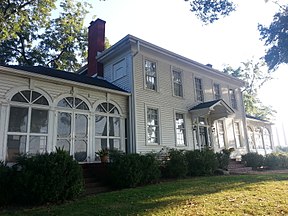Chieftains (Major Ridge Home)
| Chieftains | ||
|---|---|---|
| National Register of Historic Places | ||
| National Historic Landmark | ||
|
Chieftains, front view |
||
|
|
||
| location | Rome , Floyd County , Georgia | |
| Coordinates | 34 ° 16 '37.6 " N , 85 ° 10' 12.7" W | |
| Built | 1792 | |
| NRHP number | 71000273 | |
| Data | ||
| The NRHP added | April 7th 1971 | |
| Declared as an NHL | 7th November 1973 | |
Chieftains (German: possession of the chief ), also known as Major Ridge Home , is a two-story wooden house on Riverside Parkway 501 in Rome in the American state of Georgia .
In 1973, the building was designated a United States National Historic Landmark because it was the home of Major Ridge , an eminent Cheerokee chief . On the Cherokee side, Ridge was a major signatory to the New Echota Treaty of 1835. This treaty sealed the surrender of the Cherokee land east of the Mississippi to the United States and the relocation of the Indians in exchange for $ 5 million in compensation and land in the United States Indian territory in what is now the state of Oklahoma .
Major Ridge in Chieftains
Around 1819 Major Ridge (1771–1839) moved with his family into the log cabin in Rome. He lived there during the increasingly violent clashes between the Indians and the European Americans, in the hope of negotiating a treaty with them to prevent the expulsion of the Cherokee by the new settlers. Due to his combative nature, he initially gained a lot of reputation within the Cherokee tribe. He became a political leader and made many decisions as a representative of the Cherokee during negotiations with the “whites”. Because of his rapidly growing political power and wealth, many of his tribe members opposed him.
The Cherokee group led by Major Ridge was called the Treaty Party . Its members believed that the resettlement to Indian territory in the hopeless conflict with the European colonizers opened up the best of many poor future prospects. Ridge realized that he and his people would have no way of defeating the United States through war, but most Cherokee disagreed. They spoke out against Ridge and the Treaty Party and for the unyielding policies of his opponent, the later chief John Ross .
After being forcibly relocated to Indian Territory in Oklahoma, Ridge and several other members of the Treaty Party were murdered on behalf of John Ross in 1839. They were accused of violating Cherokee laws by assigning the original settlement area.
Chieftains - From a house to a museum
The original house was small and made of hand-worked Dogtrot-style logs , built in 1792.
Over the years after he moved in in 1819, Ridge increased the living space through additions and heights until the original log house was ultimately located entirely within a large two-story timber frame house.
This was the main building of his 0.9 km² slave owner plantation. He also extended his property to the banks of the Oostanaula River above the confluence with the Etowah River . He used the river to travel and to bring the cotton produced on the plantation to the market. The riverside area is part of Rome's Riverside Park .
Chieftains was bought out by the Junior Service League of Rome women's charity to keep it from decay. In 1971 it was rebuilt and opened to the public as a historical museum called the Chieftains Museum . In April 1971 the building was added to the National Register of Historic Places . On November 7, 1973, the building was declared a National Historic Landmark of the United States, at the same time as the home of his rival John Ross, the John Ross House in Rossville .
In 2002, the Chieftains Museum was accepted by the National Park Administration as part of the Trail of Tears , the Cherokee's historic evacuation route. This was set up in 1987 in memory of the many who died during the resettlement.
The museum's exhibits cover the life of Major Ridge and the life of the Cherokee in the 19th century in general.
See also
literature
- Benjamin Levy: "Chieftains," Major Ridge House . Historic Sites Survey, National Park Service, Washington 1973 ( Online ; accessed December 21, 2018).
Web links
- Chieftains Museum, Major Ridge Home , museum website.
- Chieftains , National Park Service , NRHP -Digital Asset No. 71000273.
Remarks
- ↑ chieftainsmuseum.org: Chieftains History ; accessed December 21, 2018.
- ↑ Levy 1973, p. Literature section .
- ^ Chieftains in the National Register Information System. National Park Service ; accessed December 21, 2018.
- ^ List of National Historic Landmarks by State, Georgia . National Park Service ; accessed December 21, 2018.
- ↑ chieftainsmuseum.org: About Chieftains Museum / Major Ridge Home ; accessed December 21, 2018.



